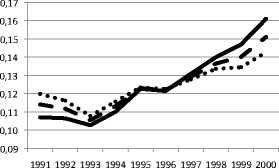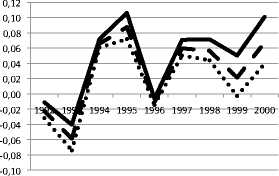information on the industries skill composition, we also refer to the German SOEP and
calculate the fraction of high to low skilled labor per industry j (Hj/Lj).9 Overall, our
panel data for the German economy covers the years 1991 - 2000 and consists of the
NACE 2 digit industries’ skill composition, their offshoring intensity, output, as well
as the relative high skill wages. For a descriptive overview of the main variables, see
Figure (2).
H/L Labor Ratio

H/L Labor Ratio (perc. change)
manu
ls
hs

ls
-------hs
manu
VS Index

VS Index (perc. change)
manu
ls
hs

ls
------hs
manu
Figure 2: Descriptive Statistics: High Skill Labor Ratio and Offshoring Activity
As expected for developed economies, the figure shows a strong skill upgrading effect
in the German manufacturing industry. The growth rate of the H/L ratio, however, is
fluctuating over the years. Also offshoring activities (the VS-index) increase over the
considered time period. While fluctuating in the first years from 1991 - 1995, a strong
increase occurred after 1995. When examining the development of the VS index in
greater detail, we observe that in Germany offshoring is more pronounced in the
relative high skill intensive industries than in the relative low skill intensive ones.10 As
shown in Falzoni and Tajoli (2010), this pattern is similar than the offshoring activities
in Italy.
form of post secondary education (4, 5, or 6).
9As Falzoni and Tajoli (2010) mention, the consideration of educational attainments is closely related
to the supply side of the labor market and highly correlated to other frequently used indices, as e.g.
the white/blue collars ratio.
10In order to distinguish between relative low and relative high skill intensive industries of the German
manufacturing sector, we follow the results of a cluster analysis done by Geishecker and Gorg (2005).
10
More intriguing information
1. The Shepherd Sinfonia2. What Lessons for Economic Development Can We Draw from the Champagne Fairs?
3. Needing to be ‘in the know’: strategies of subordination used by 10-11 year old school boys
4. Group cooperation, inclusion and disaffected pupils: some responses to informal learning in the music classroom
5. On Dictatorship, Economic Development and Stability
6. The name is absent
7. NATIONAL PERSPECTIVE
8. Chebyshev polynomial approximation to approximate partial differential equations
9. Bargaining Power and Equilibrium Consumption
10. The name is absent